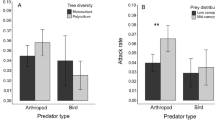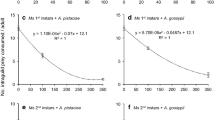Abstract
Multiple predator species feeding on a common prey can lead to higher or lower predation than would be expected by simply combining their individual effects. Such emergent multiple predator effects may be especially prevalent if predators share feeding habitat. Despite the prevalence of endophagous insects, no studies have examined how multiple predators sharing an endophytic habitat affect prey or predator reproduction. We investigated density-dependent predation of Thanasimus dubius (Coleoptera: Cleridae) and Platysoma cylindrica (Coleoptera: Histeridae) on a bark beetle prey, Ips pini (Coleoptera: Scolytidae), in a laboratory assay. I. pini utilize aggregation pheromones to group-colonize and reproduce within the stems of conifers. T. dubius and P. cylindrica exploit these aggregation pheromones to arrive simultaneously with the herbivore. Adult T. dubius prey exophytically, while P. cylindrica adults enter and prey within the bark beetle galleries. Larvae of both predators prey endophytically. We used a multiple regression analysis, which avoids confounding predator composition with density, to examine the effects of varying predator densities alone and in combination on herbivore establishment, herbivore reproduction, and predator reproduction. Predators reduced colonization success by both sexes, and decreased I. pini reproduction on a per male and per female basis. The combined effects of these predators did not enhance or reduce prey establishment or reproduction in unexpected manners, and these predators were entirely substitutable. The herbivore’s net replacement rate was never reduced significantly below one at prey and predator densities emulating field conditions. Similar numbers of each predator species emerged from the logs, but predator reproduction suffered from high intraspecific interference. The net replacement rate of P. cylindrica was not affected by conspecifics or T. dubius. In contrast, the net replacement rate of T. dubius decreased with the presence of conspecifics or P. cylindrica. Combinations of both predators led to an emergent effect, a slightly increased net replacement rate of T. dubius. This may have been due to predation by larval T. dubius on pupal P. cylindrica, as P. cylindrica develops more rapidly than T. dubius within this shared habitat.






Similar content being viewed by others

References
Aukema BH, Raffa KF (2000) Chemically mediated predator-free space: herbivores can synergize intraspecific communication without increasing risk of predation. J Chem Ecol 26:1923–1939
Aukema BH, Raffa KF (2002) Relative effects of exophytic predation, endophytic predation, and intraspecific competition on a subcortical herbivore: consequences to the reproduction of Ips pini and Thanasimus dubius. Oecologia 133:483–491
Aukema BH, Raffa KF (2004) Behavior of adult and larval Platysoma cylindrica (Coleoptera: Histeridae) and larval Medetera bistriata (Diptera: Dolichopodidae) during subcortical predation of Ips pini (Coleoptera: Scolytidae). J Insect Behav 17 (in press)
Aukema BH, Dahlsten DL, Raffa KF (2000a) Exploiting behavioral disparities among predators and prey to selectively remove pests: maximizing the ratio of bark beetles to predators removed during semiochemically based trap-out. Environ Entomol 29:651–660
Aukema BH, Dahlsten DL, Raffa KF (2000b) Improved population monitoring of bark beetles and predators by incorporating disparate behavioral responses to semiochemicals. Environ Entomol 29:618–629
Aukema BH, Richards GR, Krauth SJ, Raffa KF (2004) Species assemblage arriving at and emerging from trees colonized by Ips pini in the Great Lakes region: partitioning by time since colonization, season, and host species. Ann Entomol 97 (in press)
Ayres BD, Ayres MP, Abrahamson MD, Teale SA (2001) Resource partitioning and overlap in three sympatric species of Ips bark beetles (Coleoptera: Scolytidae). Oecologia 128:443–453
Berryman AA (1979) Dynamics of bark beetle populations: analysis of dispersal and redistribution. Bul Soc Entomol Suisse 52:227–234
Billick I, Case TJ (1994) Higher order interactions in ecological communities: what are they and how can they be detected? Ecology 75:1529–1543
Byers JA (1996) An encounter rate model of bark beetle populations searching at random for susceptible host trees. Ecol Model 91:57–66
Cook RD, Weisberg S (1999) Relating mean functions. In: Cook RD, Weisberg S (eds) Applied regression including computing and graphics. Wiley, New York, pp263–286
Cornell HV, Hawkins BA, Hochberg ME (1998) Towards an empirically-based theory of herbivore demography. Ecol Entomol 23:340–349
Denno RF, Gratton C, Peterson MA, Langellotto GA, Finke DL, Huberty AF (2002) Bottom-up forces mediate natural-enemy impact in a phytophagous insect community. Ecology 83:1443–1458
Dix ME, Franklin RT (1977) Diel activity of Thanasimus dubius, a southern pine beetle predator. J Georgia Entomol Soc 21:71–75
Erbilgin N, Nordheim EV, Aukema BH, Raffa KF (2002) Population dynamics of Ips pini and Ips grandicollis in red pine plantations in Wisconsin: within- and between-year associations with predators, competitors, and habitat quality. Environ Entomol 31:1043–1051
Fagan WF, Moran MD, Rango JJ, Hurd LE (2002) Community effects of praying mantids: a meta-analysis of the influences of species identity and experimental design. Ecol Entomol 27:385–395
Frazier JL, Nebeker TE, Mizell RF, Calvert WH (1981) Predatory behavior of the clerid beetle Thanasimus dubius (Coleoptera: Cleridae) on the southern pine beetle (Coleoptera Scolytidae). Can Entomol 113:35–43
Hawkins BA, Cornell HV, Hochberg ME (1997) Predators, parasitoids, and pathogens as mortality agents in phytophagous insect populations. Ecology 78:2145–2152
Herms DA, Haack RA, Ayres BD (1991) Variation in semiochemical-mediated prey-predator interaction: Ips pini (Scolytidae) and Thanasimus dubius (Cleridae). J Chem Ecol 17:515–524
Ihaka I, Gentleman R (1996) R: a language for data analysis and graphics. J Comput Graph Stat 5:299–314
Inouye BD (2001) Response surface experimental designs for investigating interspecific competition. Ecology 82:2696–2706
Kareiva P (1994) Special feature: higher order interactions as a foil to reductionist ecology. Ecology 75:1527–1528
Kirkendall LR (1983) The evolution of mating systems in bark and ambrosia beetles (Coleoptera: Scolytidae and Platypodidae). Zool J Linn Soc 77:293–352
Kovarik PW, Caterino MS (2002) Histeridae Gyllenhal 1808. In: Arnett RH Jr, Thomas MC, Skelley PE, Frank JH (eds) American beetles. CRC, Boca Raton, Fla., pp 213–227
Lindgren BS (1983) A multiple-funnel trap for scolytid beetles. Can Entomol 115:299–302
Losey JE, Denno RF (1998) Positive predator-predator interactions: enhanced predation rates and synergistic suppression of aphid populations. Ecology 79:2143–2152
Mazur S (1999) Preliminary studies upon the Platysoma complex (Col., Histeridae). Ann Warsaw Agric Univ—SGGW For Wood Technol 49:3–29
Mignot EC, Anderson RF (1969) Bionomics of the bark beetle predator, Thanasimus dubius Fab. (Coleoptera:Cleridae). Entomol News 80:305–310
Miller DR, Gibson KE, Raffa KF, Seybold SJ, Teale SA, Wood DL (1997) Geographic variation in response of pine engraver, Ips pini, and associated species to pheromone, lanierone. J Chem Ecol 23:2013–2031
Okuyama T (2002) The role of antipredator behavior in an experimental community of jumping spiders with intraguild predation. Pop Ecol 44:121–125
Poland TM, Borden JH (1994) Attack dynamics of Ips pini (Say) and Pityogenes knechteli (Swaine) (Col, Scolytidae) in windthrown lodgepole pine trees. J Appl Entomol 117:434–443
Polis GA, Strong DR (1996) Food web complexity and community dynamics. Am Nat 147:813–846
Polis GA, Myers CA, Holt RD (1989) The ecology and evolution of intraguild predation—potential competitors that eat each other. Annu Rev Ecol Syst 20:297–330
Raffa KF, Dahlsten DL (1995) Differential responses among natural enemies and prey to bark beetle pheromones. Oecologia 102:17–23
Raffa KF, Klepzig KD (1989) Chiral escape of bark beetles from predators responding to a bark beetle pheromone. Oecologia 80:566–569
Reeve JD (1997) Predation and bark beetle dynamics. Oecologia 112:48–54
Reid ML, Roitberg BD (1994) Benefits of prolonged male residence with mates and brood in pine engravers (Coleoptera, Scolytidae). Oikos 70:140–148
Relyea RA (2003) How prey respond to combined predators: a review and an empirical test. Ecology 84:1827–1839
Relyea RA, Yurewicz KL (2002) Predicting community outcomes from pairwise interactions: integrating density- and trait-mediated effects. Oecologia 131:569–579
Robins GL, Reid ML (1997) Effects of density on the reproductive success of pine engravers—is aggregation in dead trees beneficial? Ecol Entomol 22:329–334
Rosenheim JA (1998) Higher-order predators and the regulation of insect herbivore populations. Annu Rev Entomol 43:421–447
Rosenheim JA, Wilhoit LR, Armer CA (1993) Influence of intraguild predation among generalist insect predators on the suppression of an herbivore population. Oecologia 96:439–449
Rosenheim JA, Limburg DD, Colfer RG (1999) Impact of generalist predators on a biological control agent, Chrysoperla carnea: direct observations. Ecol Appl 9:409–417
Savely HE Jr (1939) Ecological relations of certain animals in dead pine and oak logs. Ecol Monogr 9:321–385
Schenk JA, Benjamin DM (1969) Notes on the biology of Ips pini in Central Wisconsin jack pine forests. Ann Entomol Soc Am 62:480–485
Schmid JM (1969) Laphria gilva (Diptera: Asilidae), a predator of Dendroctonus ponderosae in the Black Hills of South Dakota. Ann Entomol Soc Am 62:1237–1241
Seybold SJ, Ohtsuka T, Wood DL, Kubo I (1995) Enantiomeric composition of ipsdienol: A chemotaxonomic character for North American populations of Ips spp. in the pini subgeneric group (Coleoptera: Scolytidae). J Chem Ecol 21:995–1016
Sih A (1994) Predation risk and the evolutionary ecology of reproductive behavior. J Fish Biol 45:111–130
Sih A, Englund G, Wooster D (1998) Emergent impacts of multiple predators on prey. Trends Ecol Evol 13:350–355
Snyder WE, Ives AR (2001) Generalist predators disrupt biological control by a specialist parasitoid. Ecology 82:705–716
Snyder WE, Ives AR (2003) Interactions between specialist and generalist natural enemies: parasitoids, predators, and pea aphid biocontrol. Ecology 84:91–107
Soluk DA, Collins NC (1988) Synergistic interactions between fish and stoneflies: facilitation and interference among stream predators. Oikos 52:94–100
Spiller DA (1986) Interspecific competition between spiders and its relevance to biological control by general predators. Environ Entomol 15:177–181
Sumerford DV, Abrahamson WG (1995) Geographic and host species effects in Eurosta solidaginis (Diptera, Tephritidae) mortality. Environ Entomol 24:657–662
Swisher BJ, Soluk DA, Wahl DH (1998) Non-additive predation in littoral habitats: influences of habitat complexity. Oikos 81:30–37
Thatcher RC, Pickard LS (1966) The clerid beetle, Thanasimus dubius, as a predator of the southern pine beetle. J Econ Entomol 59:955–957
Thomas JB (1955) Notes on insects and other arthropods in red and white pine logging slash. Can Entomol 87:338–344
Van Lenteren JC, Babendreier D, Bigler F, Burgio G, Hokkanen HMT, Kuske S, Loomans AJM, Menzler-Hokkanen I, Van Rijn PCJ, Thomas MB, Tommasini MG, Zeng QQ (2003) Environmental risk assessment of exotic natural enemies used in inundative biological control. Biocontrol 48:3–38
Vet LEM, Dicke M (1992) Ecology of infochemical use by natural enemies in a tritrophic context. Annu Rev Entomol 37:141–172
Wood DL (1982) The role of pheromones, kairomones, and allomones in the host selection and colonization behavior of bark beetles. Annu Rev Entomol 27:411–446
Wootton JT (1994) Putting the pieces together: testing the independence of interactions among organisms. Ecology 75:1544–1551
Acknowledgements
We thank the Wisconsin Department of Natural Resources for providing the sites for tree and insect collection. Field and laboratory assistance by B. Burwitz and J. Ludden is greatly appreciated. This study was supported by the US Department of Agriculture USDA NRI AMD 96 04317, USDA CSREES 2001–35302–10952, the Wisconsin Department of Natural Resources, the University of Wisconsin-Madison College of Agricultural and Life Sciences, S.C. Johnson and Son Inc., and an Elsa and Louis Thomsen Wisconsin Distinguished Fellowship awarded to B.H.A. We thank J. Reeve, Department of Zoology, Southern Illinois University for helpful discussions on T. dubius biology. This manuscript was greatly improved by the comments of C. Gratton, A. Ives, R. Lindroth, J. Handelsman, J. Cronin, and two anonymous reviewers.
Author information
Authors and Affiliations
Corresponding author
Rights and permissions
About this article
Cite this article
Aukema, B.H., Clayton, M.K. & Raffa, K.F. Density-dependent effects of multiple predators sharing a common prey in an endophytic habitat. Oecologia 139, 418–426 (2004). https://doi.org/10.1007/s00442-004-1511-9
Received:
Accepted:
Published:
Issue Date:
DOI: https://doi.org/10.1007/s00442-004-1511-9



